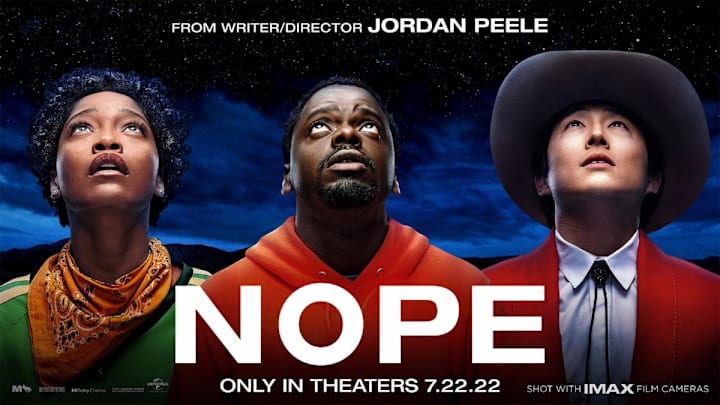Like all of Jordan Peele's movies, Nope contains many unique themes, symbols, and allusions worth investigating. You could parse Peele's films for days and still come up with new theories and takes on his stories. So we're digging into the movie's ending and dissecting the various themes and final moments. Spoilers ahead.
The film's climactic ending features Em (Keke Palmer) riding to Jupiter's Claim, the theme park formerly owned by Steven Yeun's character, Jupe (before Jean Jacket ate him). After luring the extraterrestrial to the park, Em unleashes the giant Jupe-shaped balloon into the sky. Because it has one eye opened in a winking gesture (and Jean Jacket is attracted to people staring at it), Jean Jacket immediately takes an interest and swallows the balloon, leading to its downfall as the balloon explodes inside the alien, killing it instantly.
While this high-stakes spectacle unfolds in the sky, Em uses the hand-crank wishing well camera to take as many photographs as she can, finally nailing "the Oprah shot," an image or video clip so spectacular it's destined to get the creator fame or at least net them a sit-down with Oprah Winfrey.
Dissecting the themes of Nope
Many characters die in Nope, including Jupe and the cinematographer Antlers Holst (Michael Wincott), but Em, OJ (Daniel Kaluuya), and Angel all survive the terrifying encounter. Even better, the Haywoods finally reclaim a piece of history after their ancestor was forgotten despite being part of the famous series of photographs titled Animal Locomotion by Eadweard Muybridge, featuring a Black rider on horseback that later helped shape the creation of motion pictures.
In Nope, the Haywood family are descendants of that jockey, and part of the film's central conceit is how society dictates whose stories are worth telling. Animal Locomotion is indeed a real creation, but Peele created the storyline revolving around the Haywoods and their connection to the jockey for the film.
Spectacle is another crucial theme in Nope as we see multiple scenarios where humanity's desire to capture something amazing on film has led to the downfall, or even deaths, of others. Holst foreshadows his own death by warning Em not to get caught up in her pursuit of fame but then ultimately allowing himself to get eaten alive by Jean Jacket so his camera can record it all.
Similarly, Jupe's backstory involves a chimpanzee going on a rampage while filming a sitcom episode after a balloon pop spooks him. It's fitting that a balloon also brings about Jean Jacket's downfall. Balloons pop and deflate over time, signaling the end of the party, or in this case, the end of the display or performance.
Nope likes to play with the idea of what it means to be a predator vs. its prey. We read crazy stories every day about humans interfering with animals and then getting killed or injured because of it. Sure, some animals are domesticated, but you cannot change the nature of a predator, no matter how cute or docile it appears. But that doesn't stop us from creating zoos or using animals for entertainment, often to the detriment of the animals in question.
That's why Jupe ends up getting eaten by Jean Jacket. He falsely believes he's nurtured a relationship with the being by feeding it horses when, in reality, Jean Jacket feels no attachment to Jupe and happily eats him anyway. I guess he didn't learn anything from Gordy!
To stay up to date on thrillers, sci-fi, and horror, bookmark 1428 Elm and follow our Facebook page and Twitter account!
